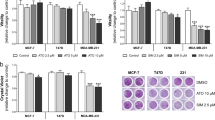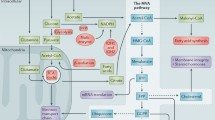Abstract
Statins directly inhibit 3-hydroxy-3-methylglutaryl-coenzyme A reductase (HMGR) activity, while γ-tocotrienol, an isoform of vitamin E, enhances the degradation and reduces cellular levels of HMGR in various tumor cell lines. Since treatment with statins or γ-tocotrienol alone induced a dose-responsive inhibition, whereas combined treatment with subeffective doses of these agents resulted in a synergistic inhibition in +SA mammary tumor cell growth, studies were conducted to investigate the role of the HMGR pathway in mediating the antiproliferative effects of combined low dose statin and γ-tocotrienol. Treatment with 8 μM simvastatin inhibited cell growth and isoprenylation of Rap1A and Rab6, and supplementation with 2 μM mevalonate reversed these effects. However, the growth inhibitory effects of 4 μM γ-tocotrienol were not dependent upon suppression in mevalonate synthesis. Treatment with subeffective doses of simvastatin (0.25 μM), lovastatin (0.25 μM), mevastatin (0.25 μM), pravastatin (10 μM), or γ-tocotrienol (2 μM) alone had no effect on protein prenylation or mitogenic signaling, whereas combined treatment with these agents resulted in a significant inhibition in +SA cell growth, and a corresponding decrease in total HMGR, Rap1A and Rab6 prenylation, and MAPK signaling, and mevalonate supplementation reversed these effects. These findings demonstrate that the synergistic antiproliferative effects of combined low dose statin and γ-tocotrienol treatment are directly related to an inhibition in HMGR activity and subsequent suppression in mevalonate synthesis.





Similar content being viewed by others
Abbreviations
- HMGR:
-
3-Hydroxy-3-methylglutaryl-coenzyme A reductase
- MAPK:
-
Mitogen-activated protein kinase
- FPP:
-
Farnesyl pyrophosphate
- GGPP:
-
Geranylgeranyl pyrophosphate
- ERK:
-
Extracellular signal-regulated kinase
- BSA:
-
Bovine serum albumin
- DMEM:
-
Dulbecco’s modified Eagle’s medium
- PBS:
-
Phosphate buffered saline
- MTT:
-
3-(4,5-Dimethylthiazol-2yl)-2,5-diphenyl tetrazolium bromide
- SDS:
-
Sodium dodecyl sulfate
- PVDF:
-
Polyvinylidene fluoride
- TBST:
-
10 mM Tris–HCl containing 50 mM NaCl and 0.1% Tween 20, pH 7.4
- TBS:
-
0.05 M Tris-buffered saline (TBS) pH 7.6
- PI3K:
-
Phosphatidylinositol 3-kinase
References
Goldstein JL, Brown MS (1990) Regulation of the mevalonate pathway. Nature 343:425–430
Kato K, Cox AD, Hisaka MM, Graham SM, Buss JE, Der CJ (1992) Isoprenoid addition to Ras protein is the critical modification for its membrane association and transforming activity. Proc Natl Acad Sci USA 89:6403–6407
Khosravi-Far R, Cox AD, Kato K, Der CJ (1992) Protein prenylation: key to Ras function and cancer intervention? Cell Growth Differ 3:461–469
Maltese WA (1990) Posttranslational modification of proteins by isoprenoids in mammalian cells. FASEB J 4:3319–3328
Mo H, Elson CE (2004) Studies of the isoprenoid-mediated inhibition of mevalonate synthesis applied to cancer chemotherapy and chemoprevention. Exp Biol Med (Maywood) 229:567–585
Shibata MA, Ito Y, Morimoto J, Otsuki Y (2004) Lovastatin inhibits tumor growth and lung metastasis in mouse mammary carcinoma model: a p53-independent mitochondrial-mediated apoptotic mechanism. Carcinogenesis 25:1887–1898
Campbell MJ, Esserman LJ, Zhou Y, Shoemaker M, Lobo M, Borman E, Baehner F, Kumar AS, Adduci K, Marx C, Petricoin EF, Liotta LA, Winters M, Benz S, Benz CC (2006) Breast cancer growth prevention by statins. Cancer Res 66:8707–8714
Thibault A, Samid D, Tompkins AC, Figg WD, Cooper MR, Hohl RJ, Trepel J, Liang B, Patronas N, Venzon DJ, Reed E, Myers CE (1996) Phase I study of lovastatin, an inhibitor of the mevalonate pathway, in patients with cancer. Clin Cancer Res 2:483–491
Staffa JA, Chang J, Green L (2002) Cerivastatin and reports of fatal rhabdomyolysis. N Engl J Med 346:539–540
Sylvester PW, Shah SJ (2005) Mechanisms mediating the antiproliferative and apoptotic effects of vitamin E in mammary cancer cells. Front Biosci 10:699–709
Parker RA, Pearce BC, Clark RW, Gordon DA, Wright JJ (1993) Tocotrienols regulate cholesterol production in mammalian cells by post-transcriptional suppression of 3-hydroxy-3-methylglutaryl-coenzyme A reductase. J Biol Chem 268:11230–11238
Wali VB, Sylvester PW (2007) Synergistic antiproliferative effects of gamma-tocotrienol and statin treatment on mammary tumor cells. Lipids 42:1113–1123
Wali VB, Bachawal SV, Sylvester PW (2009) Combined treatment of gamma-tocotrienol with statins induce mammary tumor cell cycle arrest in G1. Exp Biol Med (Maywood) 234:639–650
Danielson KG, Anderson LW, Hosick HL (1980) Selection and characterization in culture of mammary tumor cells with distinctive growth properties in vivo. Cancer Res 40:1812–1819
Anderson LW, Danielson KG, Hosick HL (1981) Metastatic potential of hyperplastic alveolar nodule derived mouse mammary tumor cells following intravenous inoculation. Eur J Cancer Clin Oncol 17:1001–1008
Shah S, Gapor A, Sylvester PW (2003) Role of caspase-8 activation in mediating vitamin E-induced apoptosis in murine mammary cancer cells. Nutr Cancer 45:236–246
McIntyre BS, Briski KP, Gapor A, Sylvester PW (2000) Antiproliferative and apoptotic effects of tocopherols and tocotrienols on preneoplastic and neoplastic mouse mammary epithelial cells. Proc Soc Exp Biol Med 224:292–301
Rao S, Porter DC, Chen X, Herliczek T, Lowe M, Keyomarsi K (1999) Lovastatin-mediated G1 arrest is through inhibition of the proteasome, independent of hydroxymethyl glutaryl-CoA reductase. Proc Natl Acad Sci USA 96:7797–7802
Rodwell VW, Nordstrom JL, Mitschelen JJ (1976) Regulation of HMG-CoA reductase. Adv Lipid Res 14:1–74
Sylvester PW, Birkenfeld HP, Hosick HL, Briski KP (1994) Fatty acid modulation of epidermal growth factor-induced mouse mammary epithelial cell proliferation in vitro. Exp Cell Res 214:145–153
Towbin H, Staehelin T, Gordon J (1979) Electrophoretic transfer of proteins from polyacrylamide gels to nitrocellulose sheets: procedure and some applications. Proc Natl Acad Sci USA 76:4350–4354
Elson CE, Peffley DM, Hentosh P, Mo H (1999) Isoprenoid-mediated inhibition of mevalonate synthesis: potential application to cancer. Proc Soc Exp Biol Med 221:294–311
Graaf MR, Richel DJ, van Noorden CJ, Guchelaar HJ (2004) Effects of statins and farnesyltransferase inhibitors on the development and progression of cancer. Cancer Treat Rev 30:609–641
Correll CC, Edwards PA (1994) Mevalonic acid-dependent degradation of 3-hydroxy-3-methylglutaryl-coenzyme A reductase in vivo and in vitro. J Biol Chem 269:633–638
Cheng KW, Lahad JP, Gray JW, Mills GB (2005) Emerging role of RAB GTPases in cancer and human disease. Cancer Res 65:2516–2519
Caron E (2003) Cellular functions of the Rap1 GTP-binding protein: a pattern emerges. J Cell Sci 116:435–440
Wang Z, Dillon TJ, Pokala V, Mishra S, Labudda K, Hunter B, Stork PJ (2006) Rap1-mediated activation of extracellular signal-regulated kinases by cyclic AMP is dependent on the mode of Rap1 activation. Mol Cell Biol 26:2130–2145
Stork PJ, Schmitt JM (2002) Crosstalk between cAMP and MAP kinase signaling in the regulation of cell proliferation. Trends Cell Biol 12:258–266
Roelofs AJ, Hulley PA, Meijer A, Ebetino FH, Russell RG, Shipman CM (2006) Selective inhibition of Rab prenylation by a phosphonocarboxylate analogue of risedronate induces apoptosis, but not S-phase arrest, in human myeloma cells. Int J Cancer 119:1254–1261
Merrell MA, Wakchoure S, Lehenkari PP, Harris KW, Selander KS (2007) Inhibition of the mevalonate pathway and activation of p38 MAP kinase are independently regulated by nitrogen-containing bisphosphonates in breast cancer cells. Eur J Pharmacol 570:27–37
Shah SJ, Sylvester PW (2005) Gamma-tocotrienol inhibits neoplastic mammary epithelial cell proliferation by decreasing Akt and nuclear factor kappaB activity. Exp Biol Med (Maywood) 230:235–241
Samant GV, Sylvester PW (2006) gamma-Tocotrienol inhibits ErbB3-dependent PI3K/Akt mitogenic signalling in neoplastic mammary epithelial cells. Cell Prolif 39:563–574
Downward J (1998) Mechanisms and consequences of activation of protein kinase B/Akt. Curr Opin Cell Biol 10:262–267
Brown MS, Faust JR, Goldstein JL, Kaneko I, Endo A (1978) Induction of 3-hydroxy-3-methylglutaryl coenzyme A reductase activity in human fibroblasts incubated with compactin (ML-236B), a competitive inhibitor of the reductase. J Biol Chem 253:1121–1128
Nakanishi M, Goldstein JL, Brown MS (1988) Multivalent control of 3-hydroxy-3-methylglutaryl coenzyme A reductase. Mevalonate-derived product inhibits translation of mRNA and accelerates degradation of enzyme. J Biol Chem 263:8929–8937
Adjei AA (2001) Blocking oncogenic Ras signaling for cancer therapy. J Natl Cancer Inst 93:1062–1074
Norbury C, Nurse P (1992) Animal cell cycles and their control. Annu Rev Biochem 61:441–470
Sebolt-Leopold JS, Herrera R (2004) Targeting the mitogen-activated protein kinase cascade to treat cancer. Nat Rev Cancer 4:937–947
Dhillon AS, Hagan S, Rath O, Kolch W (2007) MAP kinase signalling pathways in cancer. Oncogene 26:3279–3290
Coleman ML, Marshall CJ, Olson MF (2004) RAS and RHO GTPases in G1-phase cell-cycle regulation. Nat Rev Mol Cell Biol 5:355–366
Siperstein MD, Fagan VM (1964) Deletion of the cholesterol-negative feedback system in liver tumors. Cancer Res 24:1108–1115
Siperstein MD, Fagan VM (1964) Studies on the feed-back regulation of cholesterol synthesis. Adv Enzyme Regul 2:249–264
Elson CE, Yu SG (1994) The chemoprevention of cancer by mevalonate-derived constituents of fruits and vegetables. J Nutr 124:607–614
Acknowledgments
This work was performed at the College of Pharmacy, University of Louisiana at Monroe, Monroe, LA and supported in part by grants from the National Institutes of Health (Grant CA 86833) and First Tech International Ltd.
Author information
Authors and Affiliations
Corresponding author
About this article
Cite this article
Wali, V.B., Bachawal, S.V. & Sylvester, P.W. Suppression in Mevalonate Synthesis Mediates Antitumor Effects of Combined Statin and γ-Tocotrienol Treatment. Lipids 44, 925–934 (2009). https://doi.org/10.1007/s11745-009-3344-0
Received:
Accepted:
Published:
Issue Date:
DOI: https://doi.org/10.1007/s11745-009-3344-0




